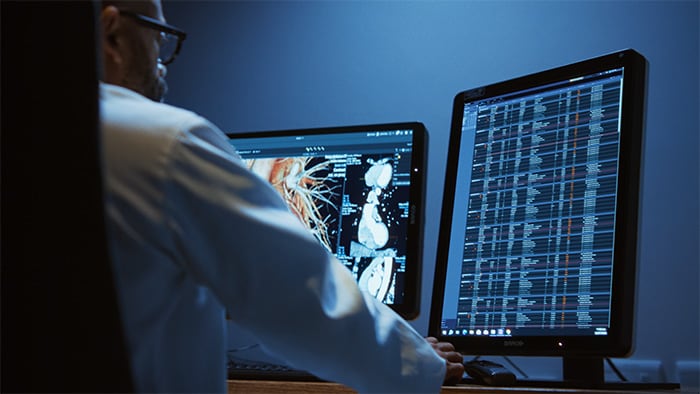There’s a reason that Adam Kay’s book about the life of a junior doctor in the UK’s NHS has sold more than 1.5 million copies and been translated into 37 languages. “This is Going to Hurt” is a funny, terrifying and heartbreaking account of healthcare. But it also describes how Kay sacrifices his free time, relationship and ultimately his mental health to deliver the best care he can to his patients. In the end, he burns out and quits the profession. And Kay is not alone. An increasing number of healthcare providers report experiencing symptoms of burnout, which is characterized by emotional exhaustion, depersonalization and a sense of reduced personal accomplishment. In the US, this includes half of physicians[1] and one third of nurses. For physicians in training, the number hits a worrying 69%. There are many causes: long hours (Kay averaged 97 a week at one point), the anxiety of making decisions that have a profound impact on people’s lives, an explosion of data without the insights to go with it, and tedious administrative tasks that distract from patient care. But arguably they all come down to one thing: in the current system, there are just not enough healthcare professionals to go around. And the economic impact is significant: physician burnout is conservatively estimated[2] to cost the US healthcare system $4.6 billion per year in physician turnover and reduced clinical hours. As well as the financial impact, burnout is also associated with poorer patient outcomes[3].
How AI could help
Here’s where I believe artificial intelligence (AI) could help. Over the next decade, smart systems will be able to aggregate information from multiple sources that currently remain trapped in silos. For each individual patient, they will pull together data from the systems that are used in his or her GP surgery, hospital or specialist center, like different Electronic Medical Records or diagnostic and monitoring solutions. This in turn should enable hospitals and care systems to interconnect solutions to create a continuum of care, without data falling through the cracks as a patient moves between locations. But what kinds of connections are needed the most? When I ask this question to the people I meet in IT, business and informatics and clinical roles at US healthcare organizations they tell me: support clinical decision making. Right now, AI is already very good at supporting point-in-time decision-making; for example, it can help radiologists by identifying and quantifying cancerous lesions from medical imaging. But in the near future, some of the biggest advances in AI will be in supporting clinical decision making based on predictive analytics. Imagine you’re a nurse sitting in an intensive care unit (ICU) one night. Although you’re alone in the unit, you’re not alone. A support team remotely keeps watch over your patients using analytics to continuously assess the potential need for intervention. The bedside monitoring devices are part of a smart system that uses AI to analyze each patient’s vital signs in the context of their medical history to help predict the risk of them having a heart attack or developing sepsis hours before it happens. And AI could help to do the opposite too: if it predicts that a patient will stabilize, she can be discharged quicker from the ICU to a step-down unit. Another cause of burnout for nurses in the ICU is alarm fatigue. Each day, staff can be exposed to as many as 350 alarms[4] per patient. In the future, we will see AI help to create a totally silent ICU. In this calmer environment, nurses and doctors will use tools that adapt to their individual ways of working; like advanced visualization to get the insights they need from complex information, and voice-bots[5] to enter observations and commands without typing, while tedious reporting[6] will be largely automated, freeing up time to spend with her patients.
Caring for super-users in their homes
Or how about care beyond hospital walls? One of the reasons we’re seeing increasing pressure on healthcare systems is the fact that just a small percentage of people in most countries account for a huge proportion of the expenditure (in the US, it’s the top 5%[7] that make up 50% of the costs). These so-called “super-users”, which include people with multiple chronic diseases and complex medications, are also growing in number. But by using a similar approach to the virtual ICU, healthcare providers could monitor super-users at home to improve outcomes and ease some of the pressure put on emergency and acute care. Patients and providers could connect at the right time via smart devices and voice-bots, guided by analytics that flag which patients are most in need. For both doctors and nurses, AI can help to address burnout by predicting if certain frail or elderly patients will experience an emergency medical event before it happens, which gives the care team enough time to intervene and prevent an adverse event from occurring. And if you’re a care manager with hundreds of patients to oversee, AI can help prioritize the patients you need to focus on and coordinate the necessary resources. It can also tell you the type of outreach that would be most effective based on the specific condition of each patient. In the future, this could extend to an AI-enabled clinical and operations control center[8] that matches supply with demand for healthcare services.
Interoperability is still the main challenge
From a technical perspective, our industry has still got a bit of work to do to connect the dots in order to enable more real-time insights. One of the main challenges clearly is interoperability, as well as the security and accuracy of algorithms. With that in mind, Philips launched a set of AI principles[9] in January, which we’re using to help us to design ethical, responsible and transparent AI solutions. Our ultimate goal is to support patients and clinicians alike. Because while I think that AI has the potential to do incredible things, it will never be able to replace the powerful human empathy that doctors like Adam Kay have for their patients. And we simply can’t afford to lose more like him. References [2] https://www.ncbi.nlm.nih.gov/pubmed/31132791 [3] https://jamanetwork.com/journals/jamainternalmedicine/fullarticle/2698144 [4] https://www.ncbi.nlm.nih.gov/pubmed/26539788 [5] https://www.hipaajournal.com/hipaa-compliant-alexa-skills/ [6] https://www.auntminnie.com/index.aspx?sec=rca&sub=rsna_2019&pag=dis&ItemID=127602 [7] https://www.newyorker.com/magazine/2011/01/24/the-hot-spotters [8] https://www.linkedin.com/pulse/what-hospital-operations-can-learn-from-air-traffic-control-tas/ [9] https://www.philips.com/a-w/about/artificial-intelligence/philips-ai-principles.html
Explore Philips’ unique Care Collaboration Experience through the Philips Virtual HIMSS site at www.philips.com/HIMSS and follow @PhilipsLiveFrom for #VirtualHIMSS20 updates.
Share on social media
Topics
Author

Jeroen Tas
Chief Innovation & Strategy Officer Jeroen is an experienced global executive and entrepreneur with a track record of leading innovation in the healthcare, information technology and financial services industries. Leading the company’s global Innovation & Strategy organization, he’s responsible for creating a pipeline of innovative business propositions that address emerging customer needs and enable a high-growth, profitable health continuum strategy.
Follow me on













